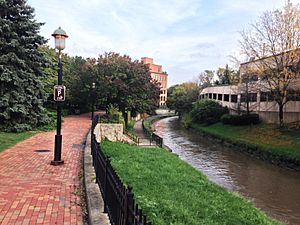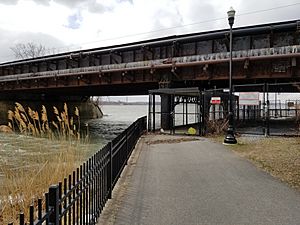Onondaga Creekwalk facts for kids
The Onondaga Creekwalk is a cool path in Syracuse, New York. It's about 4.8 miles (7.7 km) long. You can bike, skate, or walk on it. The path follows Onondaga Creek from Kirk Park, through downtown Syracuse, all the way to Onondaga Lake.
Sometimes the path is a brand new trail right next to the creek. Other times, it uses existing sidewalks or streets. This happens when there are buildings or other things in the way. If you add other nearby park roads, the total path can be about 6.1 miles (9.8 km) long.
Contents
Building the Onondaga Creekwalk
People have wanted a path along Onondaga Creek for a long time. The idea first came up in 1965. A landscape architect named Steve Buechner suggested it. But the idea didn't really start moving until 1988. That's when a company called Pyramid mentioned building a part of the path. This first part would be in the Franklin Square area. This news came out when there were big plans for the Destiny USA mall and the Lakefront area.
First Section of Phase 1
The very first part of the Creekwalk opened in September 1990. It was about 3/8ths of a mile long. Pyramid paid for it, costing $1.68 million. They expected to get the money back later.
When this section opened, people hoped the rest of the path would be built quickly. They thought the path would reach Armory Square by 1992. Then, they hoped it would go all the way to Onondaga Lake a few years after that. But it actually took more than 20 years to finish the rest of Phase 1.
Second Section of Phase 1
In July 1993, work started on another part of the Creekwalk. This section was 1,600 feet long. It was built near the Inner Harbor, which used to be an old canal area. This part cost $500,000. The money came from a settlement about pollution in Onondaga Lake.
Finishing Phase 1
The entire first phase of the Creekwalk was finally finished in October 2011. This part of the path cost $10.1 million. It was 2.6 miles (4.2 km) long. It mostly followed Onondaga Creek and the Inner Harbor. This section connected the Museum of Science and Technology (The MoST) in Armory Square north to Onondaga Lake near Destiny USA.
In some spots, the path had to move away from the creek. This was because of buildings or other things in the way. For example, it moved away between West Washington and West Genesee streets downtown. It also moved away for a short part between Spencer and West Kirkpatrick streets.
In Fall 2018, the very northern end of the path closed. This part goes under the CSX train tracks to a viewing area at Onondaga Lake. It closed because ice and waves damaged the pavement. They said repairs would happen when a new lake viewing area was built. However, since then, the gates to this part of the path have been open most of the time. Even in winter, when many Bald Eagles visit Onondaga Lake, you can often use this section.
Phase 2
Phase 2 of the Creekwalk was finished in July 2020. Planning for this part started in 2014. Construction began in February 2019. This section cost $11.4 million.
Phase 2 starts in Armory Square. It is a 2.2-mile (3.5 km) extension. Project planners say it stays close to Onondaga Creek for most of its length. But in the downtown area, it had to move away from the creek. This was due to lack of space, flooding, and cost.
Instead, the path leaves the creek from Walton Street. It goes over to South West Street. It ducks under a raised railroad bridge. Then it runs south for seven city blocks to West Onondaga Street. Most of this part of the path was already planned for bikes.
The Creekwalk then goes through a new green space. It meets the creek again between West Onondaga and Temple streets. It stays on the west side of the water. It goes through four street crossings: Temple Street, West Taylor Street, Tallman Street, and Midland Avenue. At the Midland Avenue bridge, the path crosses to the east side of the water.
Then the Creekwalk runs next to Dr. Martin Luther King West (formerly West Castle Street) for four blocks. One of these blocks is a street crossing at South Avenue. The path crosses back to the west side of the creek at Rich Street. Then it leads into Lower Onondaga Park.
Near Lower Onondaga Park and Kirk Park, South Avenue crosses the path again. But here, the Creekwalk goes under the South Avenue bridge, just like the creek does. A bit further, the path hugs the creek behind an old stone park building. City planners call it the Travelers' Rest Building. This name remembers a time in the 1920s and 1930s. Back then, this part of Kirk Park had a seasonal Tourists' Camp. Phase 2 ends at a parking lot where Hunt and Rockland avenues meet. This is one block north of West Colvin Street.
Phase 3 (Future Plans)
Phase 3 of the Creekwalk is not built yet. This future part aims to extend the path all the way south to Dorwin Avenue. This is in Syracuse's "Valley" neighborhood. It would go even further upstream along Onondaga Creek.
However, a big part of this route is already usable. From where Phase 2 ends, there are 1.3 miles (2.1 km) of roads. These roads have low traffic and are good for walking or riding. They are called Onondaga Creek Parkway or Onondaga Creek Boulevard. Further upstream, there is already mowed grass along the creek. But much of it is fenced off.
Connecting to Other Trails
At its northern end, the Creekwalk connects to other trails. It was always meant to link up with the Loop the Lake Trail. This trail goes all the way around Onondaga Lake. A direct connection from the Creekwalk to the Loop the Lake Trail opened on December 31, 2020. This new connection is part of both the Loop the Lake Trail and the Empire State Trail. The Empire State Trail is a huge path that goes across upstate New York. It generally follows the old Erie Canal. Also, the part of the Onondaga Creekwalk north of Water Street and south of West Bear Street is now part of the Empire State Trail.



